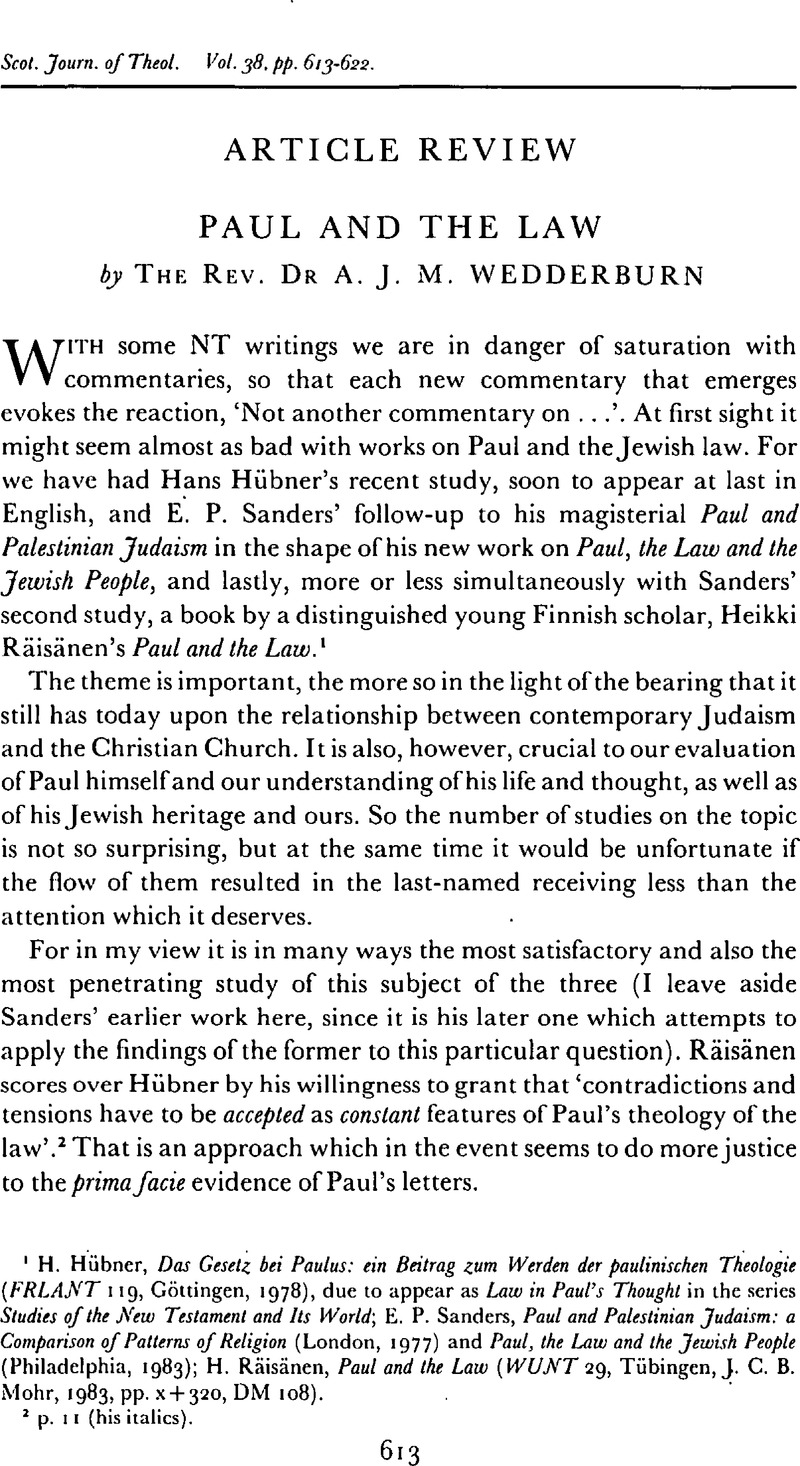Article contents
Paul and the Law
Published online by Cambridge University Press: 02 February 2009
Abstract

- Type
- Article Review
- Information
- Copyright
- Copyright © Scottish Journal of Theology Ltd 1985
References
page 613 note 1 Hübner, H., Das Gesetz bei Paulas: ein Beitrag zum Werden der paulinischen Theotogie (FRLANT 119, Göttingen, 1978)Google Scholar, due to appear as Law in Paul's Thought in the series Studies of the New Testament and Its World; Sanders, E. P., Paul and Palestinian Judaism: a Comparison of Patterns of Religion (London, 1977)Google Scholar and Paul, the Law and the Jewish People (Philadelphia, 1983)Google Scholar; Räisänen, H., Paul and the Law (WUNT 29, Tübingen, J. C. B. Mohr, 1983, pp. x + 320, DM 108).Google Scholar
page 614 note 2 p. 11 (his italics).
page 614 note 3 In contrast to Hübner, Geselz, pp. 76–80.
page 614 note 4 Here and elsewhere he quotes with approval Gardner, P., The Religious Experience of St Paul (London/New York, 1913 2), here p. 162Google Scholar, as well as appealing to Sanders.
page 615 note 5 In Die Gesetzesauslegung Jesu: ihr historischer Hintergrund im Judentum und im Alten Testament 1: Markus und Parallelen (WMANT 40, Neukirchen, 1972).Google Scholar
page 615 note 6 ‘St Paul and the Law’, SJTh 17 (1964), pp. 43–68, as well as his commentary on Romans (ICC, Edinburgh, 1975, 1979).
page 615 note 7 So Osten-Sacken, P.v.d., Römer 8 als Beispiel paulinischer Soteriologie (FRLANT 112, Göttingen, 1975)CrossRefGoogle Scholar and Hübner, op. cit.
page 616 note 8 The Diatribe and Paul's Letter to the Romans (SBLDS 57, Chico, 1981).Google Scholar
page 617 note 9 Cf., e.g., 2 Esd. 3.21 — whence came this ‘evil heart’ which led to Adam's first transgression? (‘Clothing himself is a dubious translation of baiolans, pace Räisänen, p. 190; ‘burdened’ as in Metzger's, B. M. translation in (ed.) Charlesworth, J. H., The Old Testament Pseudepigrapha 1 (London, 1983), p. 529Google Scholar, is far better!). We are not told. Cf. the very similar ‘glaring self-contradiction’ which Räisänen finds in Rom. 7.7–14 (p. 142): the law is needed to induce sin but finds us already ‘sold under sin’.
page 618 note 10 ‘The New Perspective on Paul’, BJRL 35 (1983), pp. 95–122, here pp. 107, 110Google Scholar; Räisänen (p. 259) grants that in Gal. 2.16 Paul has in mind ‘the keeping of ritual requirements’.
page 618 note 11 And hence I suspect that Räisänen would, rightly, object to statements like ‘Paul is as little opposed to the law per se as he is to good works per se’ (Dunn, loc. cit., p. 118) on the grounds that passages like Gal. 3.19 do seem to express opposition to the law per se; if Paul means what Dunn suggests then Paul has expressed it poorly.
page 618 note 12 Paul and Palestinian Judaism, pp. 551f.
page 619 note 13 Sanders, ibid., p. 551 (italics his).
page 621 note 14 The 40s were after all marked by the restoration of direct Roman rule following Herod Agrippa l's death and by disturbances like Theudas' revolt; food shortages can only have heightened the tension.
page 621 note 15 So Hengel, M., ‘The Origins of the Christian Mission’ in Between Jesus and Paul: Studies in the Earliest History of Christianity (London, 1983), pp. 48–64, here p. 57.Google Scholar
page 621 note 16 ibid.; cf. also N. A. Dahl, ‘The Doctrine of Justification: Its Social Function and Implications’ in Studies in Paul: Theology for the Early Christian Mission (Minneapolis, 1977), PP.95–12O, here p. 115.
- 5
- Cited by




